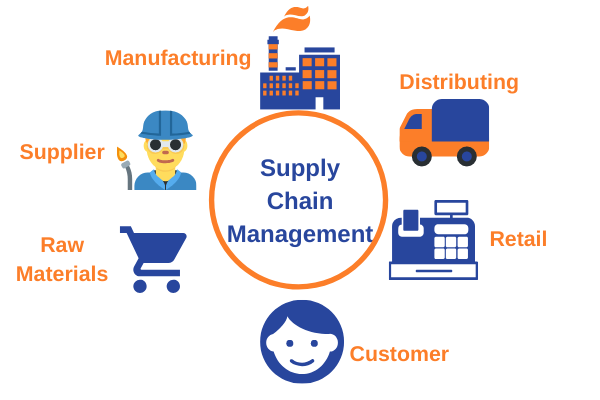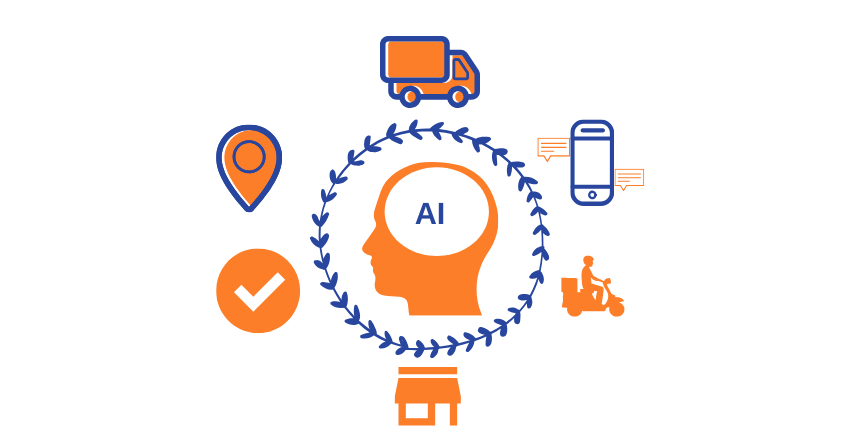The top most challenges in supply chain management are demand forecasting and warehouse optimization. And, by using AI in supply chain management, organizations can address these challenges, apart from automating other critical processes in SCM.
 SCM is an overarching process in any organization that manufactures and sells assorted products. It starts with procuring raw material from suppliers/ vendors, converting the raw material into finished products through manufacturing processes, maintaining working inventory as the respective processes demand, moving the finished products through geographically scattered distribution channels or retail locations so as to finally reach the end customers.
SCM is an overarching process in any organization that manufactures and sells assorted products. It starts with procuring raw material from suppliers/ vendors, converting the raw material into finished products through manufacturing processes, maintaining working inventory as the respective processes demand, moving the finished products through geographically scattered distribution channels or retail locations so as to finally reach the end customers.
There are 5 governing factors in the whole of the SCM process:
Planning starts with demand. It is the process of collecting historical data and past sales and thereafter, applying statistical methods to analyze the demand.
Sourcing is the process of identifying the right suppliers and contracting with them. It includes ordering and receiving raw materials from the contracted suppliers / vendors.
Making is the process of manufacturing the products. It includes assuring the quality of products manufactured, packaging the products for shipping, and finally, scheduling them for delivery.
It is the process of delivering products to the end customer. This process is also called logistics.
Returning is the process of returning defective, excess, and unwanted products to the warehouse.
According to a study done by McKinsey & Company, businesses gain between $1.3 trillion and $2 trillion a year by using Artificial Intelligence in Supply Chain Management. One of the main reasons progressive businesses are using AI in SCM is to address the problem of logistics globally.
 Further, these businesses are also using AI in SCM to enhance the customer experience by providing on-time delivery and reducing undamaged deliveries.
Further, these businesses are also using AI in SCM to enhance the customer experience by providing on-time delivery and reducing undamaged deliveries.
Benefits of using AI in Supply Chain Management:
- AI can manage the supply and demand of the products
- AI can provide real-time status of the customer purchased products
- AI can optimize warehouse operations
- AI can reduce the operational costs
- AI can make improve the efficiency of inventory management
- AI can provide better customer solutions
- AI can improve the delivery process and maintain the safety
Demand is the main factor in planning. If the supply does not meet the current demand or the supply is more than the current demand, the business incurs a financial loss and wastage of resources. Using AI, a business can predict demand with reasonable accuracy and can be used to maintain an optimum inventory of both raw material and finished products so as to minimize financial loss.
AI can collect data from historical and past sales and thereafter, predicts the future demand for business products and services. Businesses can use the predicted information to maintain a nearly accurate supply volume according to the demand.
Identifying the right supplier is the most critical factor in SCM. Selecting the right supplier also reduces the risk in the supply chain. To identify the right suppliers, relevant data is needed – like the supplier delivery performance, raw material quality, and credit score information, etc.. AI can collect this data and provide actionable insights to make accurate decisions on the right suppliers.
The purpose of implementing AI in logistics is to automate non-value adding activities and thereby, reduce overall costs. AI can be used to optimize several warehouse operations. Of these, two important operations in any warehouse that can be automated using AI are: a) maintaining optimum inventory levels, and b) route planning.
According to the logistics, every mile is important to deliver the end products to the customers. So route planning is the crucial factor in the delivery process. AI can help the process of shipping by optimizing the routes. Further, AI can also predict traffic and weather conditions. Accordingly, businesses can do proper route planning to deliver their products to customers on time without delays in the delivery process.
Any vehicle used to pick up products from the warehouse and deliver them to end customers needs at least two drivers per vehicle as a single person can not drive long hours. To address this problem of doubling the drivers, progressive businesses are implementing autonomous vehicles powered by AI in the supply chain. The autonomous vehicles are driver-less vehicles and are likely to bring a huge change in logistics compared to traditional logistics.
Traditional methods of checking damaged goods manually before shipping is a hugely time-consuming process and often incurs human errors that might result in defective products being shipped to the end customers. It does impact the business brand. To address this problem, businesses are hugely investing in automated quality checkups before shipping. The automated quality checkups use machine learning techniques to check the packages or container goods through image recognition. This ML technology will reduce the shipping of damaged goods to the customers.
Artificial intelligence can personalize the relationship between customers and logistics providers. The customers can raise the queries through voice or text in chatbots to know about the status of their orders.
To conclude, we find that AI can greatly enhance the efficiency of the whole of supply chain management and make it more effective to provide the best possible customer experience.

